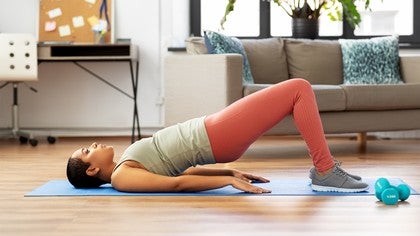
Top Tips for Exercise During Pregnancy
Pilates Anytime recently asked our pre- and postnatal fitness experts for their top tips on exercise during pregnancy. What follows are their suggestions for feeling your best during pregnancy and beyond. Remember to always check with your doctor before beginning any new exercise routine to make sure you are cleared for exercise.
“Pregnancy is a perfect time to reintroduce yourself to your body and create new habits,” says Wendy Foster, a Pilates instructor and the founder of Mamalates , based in Portland, Oregon. “Maybe regular exercise is new for you and you want to do everything you can to have a healthy baby. If so, start with safe, bite-sized pieces of mindful movement and incorporate them into your everyday life.”
That could be taking short walks and focusing on your breathing, finding a seated, lying, or standing stretch routine to counteract lower back stress caused by pregnancy, or starting a short upper body strength training routine so you’re prepared to cart around the baby and all of his or her gear.
Foster points out that the female body produces a hormone called relaxin during pregnancy that facilitates the birth process by increasing the laxity (flexibility) in the pelvis. While that’s important for delivery, it can create the risk of over-stretching during exercise, leading to injury.
“When exercising throughout your pregnancy, remember the 70 percent rule,” says Foster. “Staying in the 70 percent zone when twisting, reaching, or bending will help you maintain stability during pregnancy and into motherhood.”
According to Carolyne Anthony, founder and creative director of The Center for Women’s Fitness in Chicago, Illinois, it’s important to identify what you hope to gain from your prenatal movement practice. “What are you exercising for? To feel good, keep in shape, or to prepare your body for the birth of your baby?” she asks. Perhaps it’s a combination of these, or even all three.
“If your goal is to prepare your body for pregnancy, birth, and motherhood, you will need to understand the changes your body is going through and find ways to support them,” says Anthony.
To that end, she offers these guidelines:
- Don’t focus on strengthening one body part (such as the pelvic floor) so much that you neglect other muscle groups.
- Prioritize whole-body movement that is coordinated with the breath.
- Create ease of movement. Don’t strain against resistance.
- Instead of pushing yourself to work harder, look for opportunities to open and release the body in preparation for childbirth.
Sometimes, what’s most beneficial for expectant mothers is a mental shift, not a physical one. That can be as subtle as reframing how you look at exercise.
“My top suggestion for prenatal exercisers is that they use this time to fine-tune skills,” says Georgia Burns, OTA/PTA, doula, and founder of Pilates Mechanics in Toronto, Canada. “Rather than focus on strength, we can shift the focus to precision. Try looking inward to find the gentle rhythm in each exercise.”
Burns notes that rocking and rhythmic movements can help shift the nervous system into a more relaxed state. This is key in labor, too.
Simply cutting yourself some slack can be the most effective form of self-care. After all, your body is hard at work, growing a human being.
“When I was pregnant with my first child, I was surprised at how quickly I became out of breath during exercise,” says Los Angeles, California-based Pilates instructor Carrie Macy Samper, director of Pilates education at Equinox and creator of the Equinox Pilates Teacher Training Programs.. “Then I learned that pregnant women have on average 50 percent more blood volume. My heart was working harder to pump all of that fluid around. When I added Pilates to that, of course I got out of breath.”
If, like Samper, you were used to doing a strong, vigorous, and challenging workout pre-pregnancy, having to dial back your practice can be a humbling experience.
“The important thing is to move in a way that makes you feel good when you are pregnant, not to keep up with what you did before,” says Samper. “As your pregnancy progresses, your workout needs and abilities will also change. I felt much more disconnected from my Powerhouse, for obvious reasons, and that meant my Pilates workout felt more piecemeal to me.”
In addition to adapting to the physical limitations of a pregnant body, pregnancy affects self-esteem and body image. Even a professional mover like Samper was not immune to the emotional ups and downs of inhabiting a changing body.
“Everyone expects you to be so happy when you are pregnant, and while you are happy about that little baby coming, no longer having complete control over your body or how you look is stressful,” she says. “You have known your body as it was for, in my case, 38 years, and suddenly you are growing in places you never have before.”
Samper’s suggestion: “Try to embrace this time of your life as a different chapter and focus on the amazing things your body is doing to create a new life,” she says.
Comments

You need to be a subscriber to post a comment.
Please Log In or Create an Account to start your free trial.












